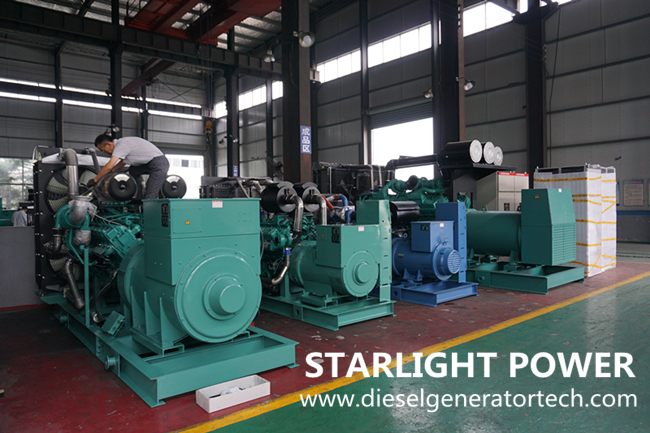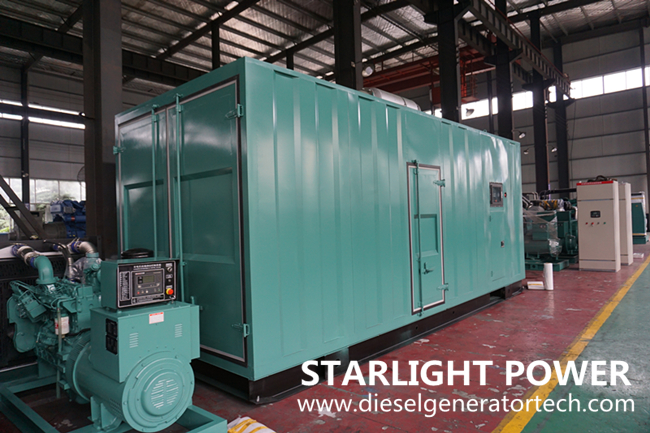The cooling way of diesel generator has water-cooled and air-cooled, what is the difference between water-cooled generator and air-cooled generator? Here is something you should know.
Water-cooled Diesel Generator:
Its cooling system uses water as the cooling medium, and then dissipates heat through cooling water tank and fan to ensure the normal working temperature of the diesel engine.
The water cooling system consists of water pump, radiator, fan, thermostat, water jacket and water pipe. The coolant of the water cooling system is located in the water jacket of the engine. The temperature of the high temperature machine is absorbed and the temperature rises, the radiator is cooled by fans and upwind airflow, and then the coolant is pumped into the water jacket for cyclic cooling.
There are two ways of circulating coolant: the thermostat closes when the engine water temperature is below 70 °C, coolant flows through pump, water jacket, heater bypass pipe, pump (without radiator), that is small circulation, this is conducive to rapid temperature rise after engine start-up; When the water temperature of the engine exceeds 70 °C, the thermostat opens automatically, and the coolant flows through the pump, water jacket, temperature control switch valve, radiator and water pump, that is, the large circulation, to enhance the cooling effect. Coolant is usually soft water to reduce the scale deposition in the inner wall of radiator and water jacket, affecting the heat dissipation effect. We need to use antifreeze in cold areas or in winter.

Water cooling systems usually have auxiliary containers (also known as expansion boxes), which are connected to radiators. When the coolant is heated and expanded to form steam, the steam valve on the radiator cover stores water and steam overflowing the radiator during cooling. When the liquid cools down, it can be supplemented to the radiator by a drain valve.
The cylinder of water-cooled engine is cast with complex cooling water channel (dry cylinder liner) or forms cooling water channel (wet cylinder liner) with cylinder liner. The piston works in the cylinder liner and the heat is transferred through the cylinder liner to the cooling water in the water channel to implement cooling. This method is usually used in four-stroke engines.
Characteristics of water-cooled generators:
1.Water cooling systems has many requirements for environment, complex structure and relatively difficult manufacturing. When used in plateau, the boiling point of water decreases, and easy to freeze in alpine region when shutdown occurs. It is necessary to improve the boiling point and freezing point by adding a certain proportion of additives;
2.The effect of water cooling is ideal. The generator with the same technical parameters has small volume, light weight, high energy density and good heat transfer performance;
3.Water cooling generator is the most common type, such as Cummins, Volvo, Perkins etc. Widely used in agricultural machinery, construction machinery, automobile industry, marine machinery, electric power industry and other fields.
Air-cooled diesel generator:
Engine cylinder block and cylinder liner of air-cooled diesel generator set integrate or connect to clearance-free unit. The inner part is the working area of piston sliding, and the outer part is uniformly arranged and radiated intensively. Usually, materials with high thermal conductivity are die-cast. The working heat of the piston is transferred directly through the cylinder and is carried away by the flowing air between the radiators. This method is usually used in two-stroke engines.
Air cooling uses air as cooling medium. High-speed air directly removes heat from high-temperature components to reduce engine temperature. Air cooling is divided into natural air cooling and forced air cooling. Natural air cooling is the direct cooling of cylinder head, cylinder and other components by the air flow generated by mechanical movement. In order to improve the efficiency of heat dissipation, air-cooled engine uses to increase the heat dissipation area of engine surface, that is, casting the body of radiator on the outer surface of cylinder head, cylinder liner and cylinder, etc.
At higher temperatures, such as near the combustion chamber and exhaust port, the heat dissipation area is larger. Radiator should be smooth and clean to improve heat dissipation performance; forced air-cooled fan should be used to increase the flow rate of air passing through the radiator to improve cooling effect. That is to say, the engine itself drives the fan to increase the flow rate and velocity of the air flow, and reliably cools the cylinder head, cylinder liner, cylinder block and so on by reasonably distributing the air guide hood.
Characteristics of air-cooled generators:
1.The air-cooled generator set must be installed in the open room. The noise is bigger and the cooling effect is not as good as that of water cooling;
2.The biggest advantages are simple structure, easy maintenance, less air requirement, low fuel consumption, and no risk of frost cracking or superheated boiling;
3.Air-cooled diesel generators are suitable for plateau or water shortage, cold places, you do not need to add water and worry about boiling point, freezing and other issues, due to heat load and mechanical load limitations, power is generally relatively small.

If you plan to have a diesel generator, depending on your requirement, i think you have known which is better after learn the above informations. Starlight manafacturer will provide professional technical support and high quality generator setall the time, welcome to inquiry.
Comments
Post a Comment